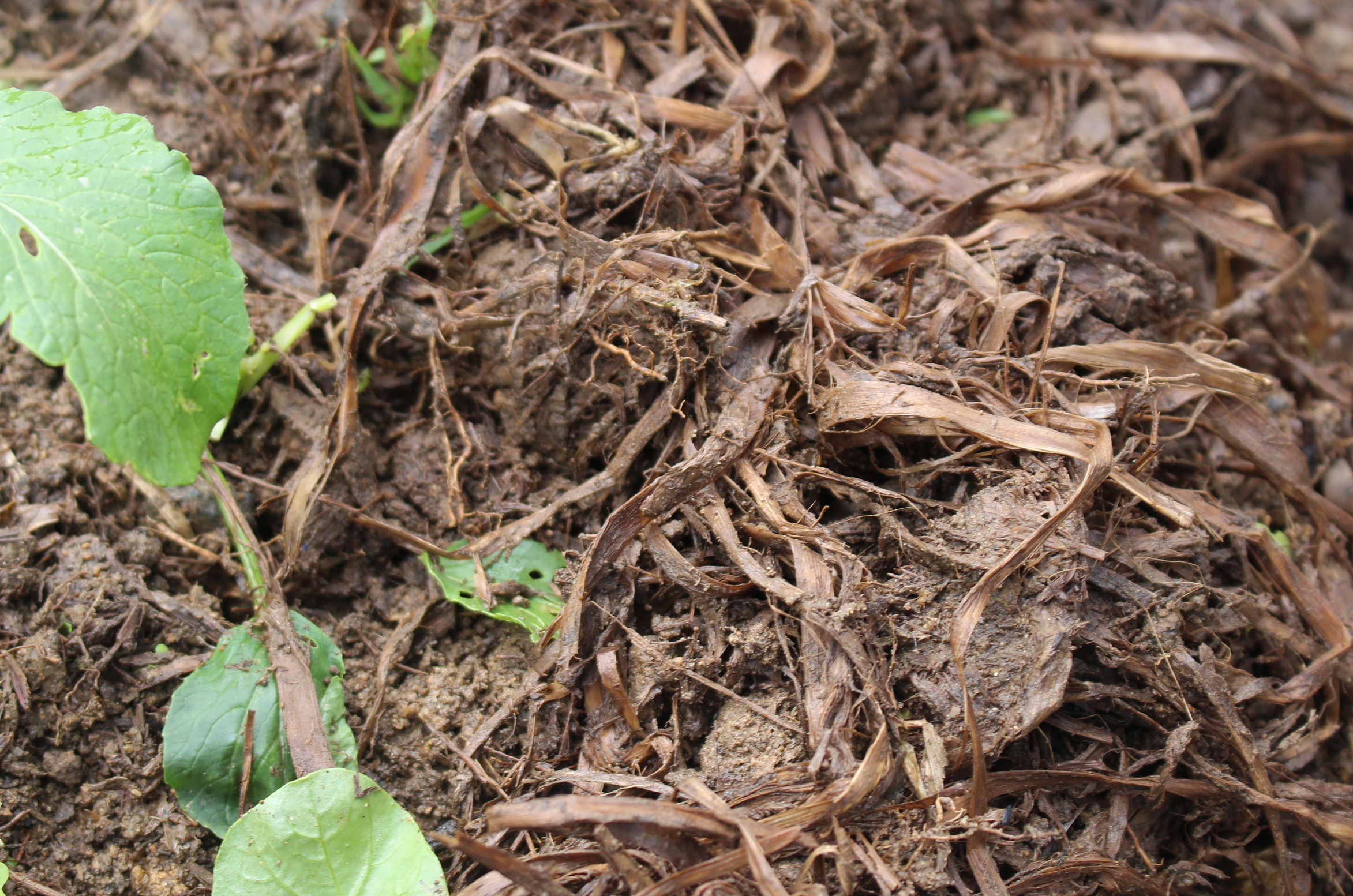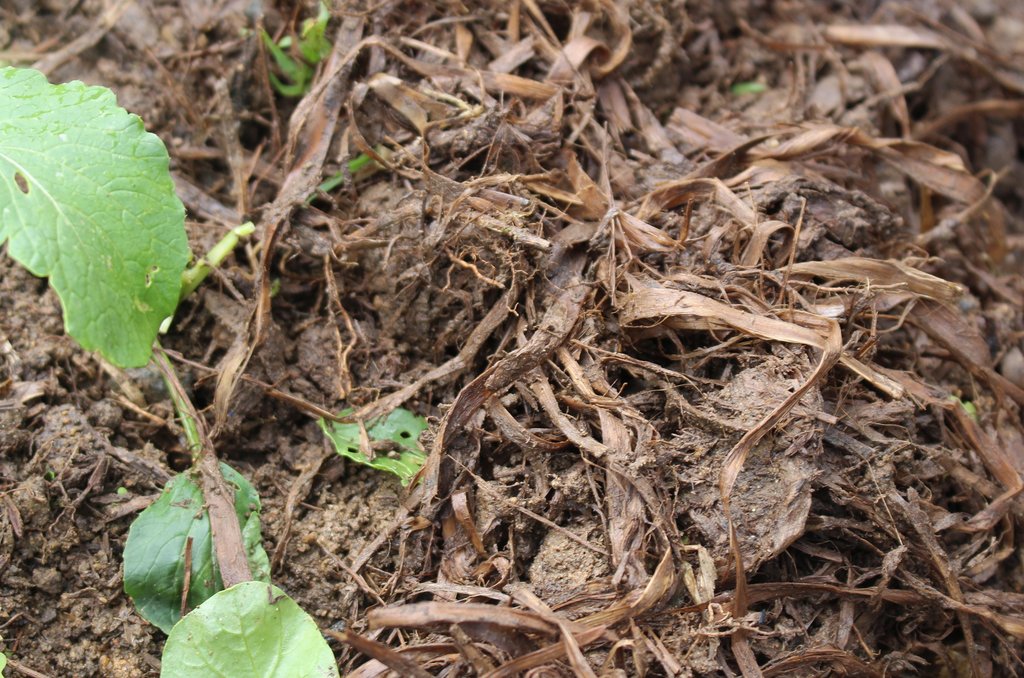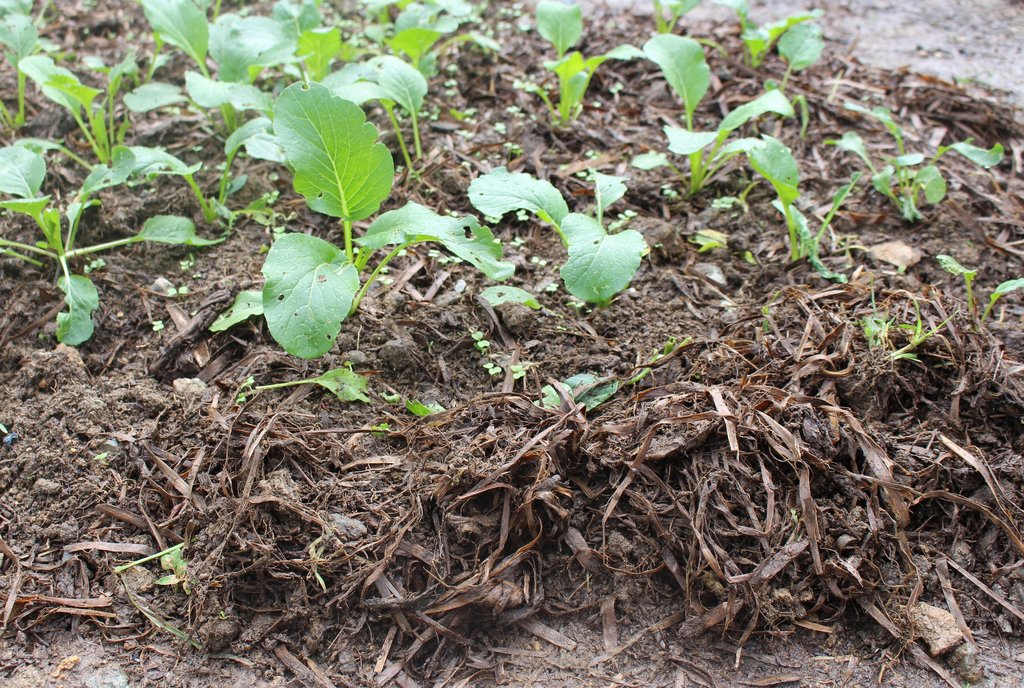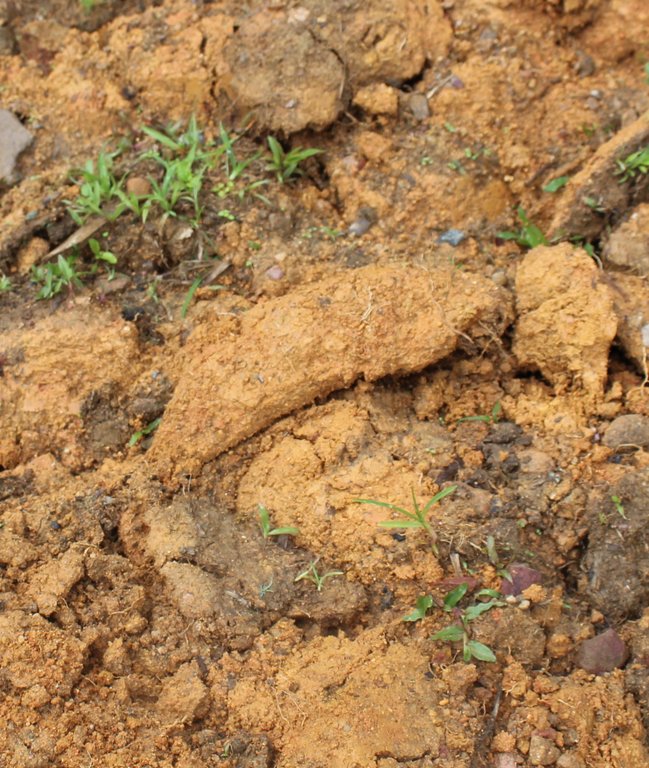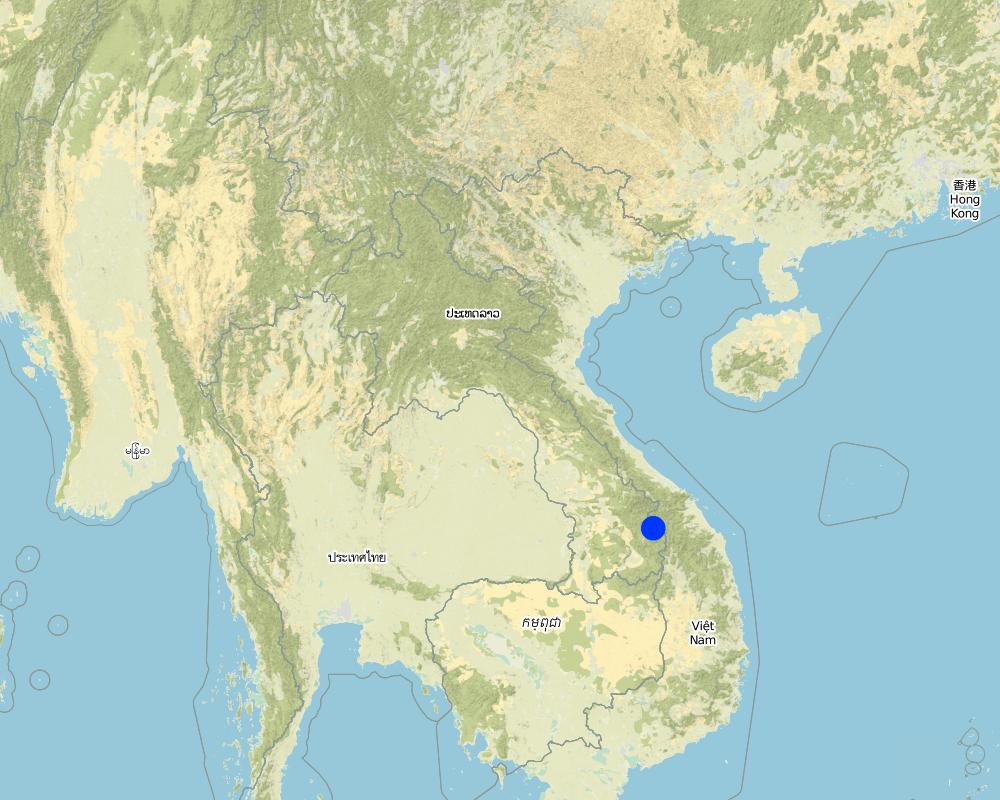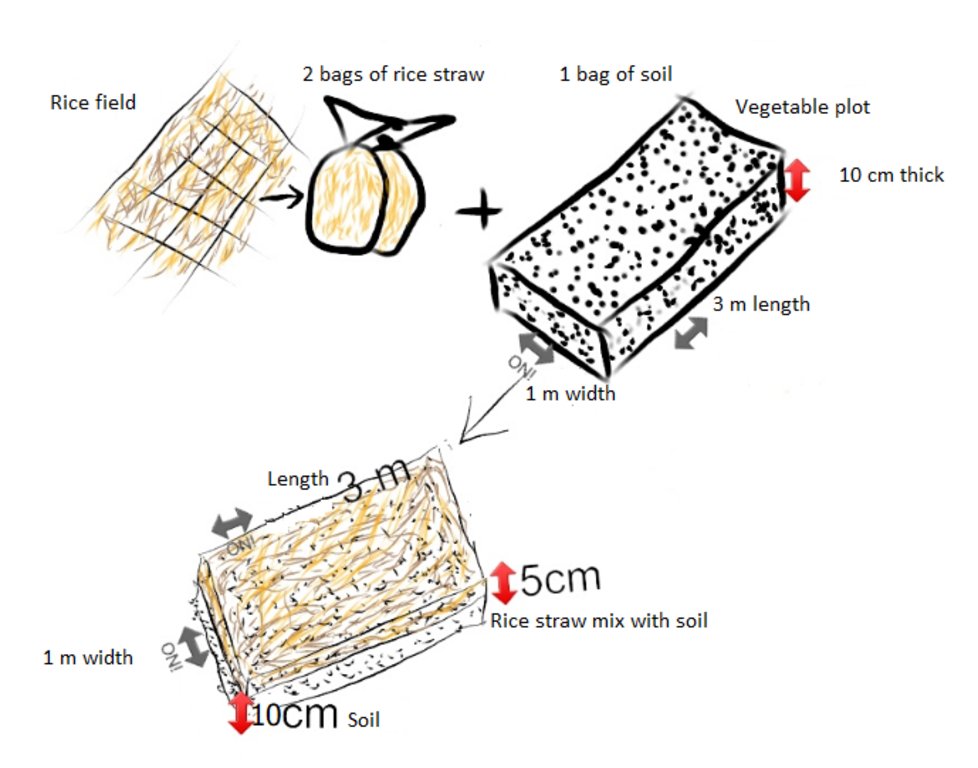Rice straw mulching in vegetable home gardens [Lao People's Democratic Republic]
- Creation:
- Update:
- Compiler: Bounthanom Bouahom
- Editor: kang phanvongsa
- Reviewers: Nivong Sipaseuth, Nicole Harari
technologies_2061 - Lao People's Democratic Republic
View sections
Expand all Collapse all1. General information
1.2 Contact details of resource persons and institutions involved in the assessment and documentation of the Technology
Key resource person(s)
land user:
Soudaphone Lindasouk
030 9543425 / 020 98587726
Darktaork noy village, Darkchung district of Xekong province
Lao People's Democratic Republic
Name of project which facilitated the documentation/ evaluation of the Technology (if relevant)
Scaling-up SLM practices by smallholder farmers (IFAD)Name of the institution(s) which facilitated the documentation/ evaluation of the Technology (if relevant)
National Agriculture and Forestry Research Institute (NAFRI) - Lao People's Democratic Republic1.3 Conditions regarding the use of data documented through WOCAT
When were the data compiled (in the field)?
05/04/2017
The compiler and key resource person(s) accept the conditions regarding the use of data documented through WOCAT:
Yes
1.4 Declaration on sustainability of the described Technology
Is the Technology described here problematic with regard to land degradation, so that it cannot be declared a sustainable land management technology?
No
2. Description of the SLM Technology
2.1 Short description of the Technology
Definition of the Technology:
The Technique of using decomposed rice straw in household gardening is an effective soil improvement practice carried out by the local people. The decomposed rice straw helps to improve soil moisture, provides organic matters to the soil, which a cost- effective soil amendment practice, and results finally in increased crop yields.
2.2 Detailed description of the Technology
Description:
Rice straw mulching was initiated locally in Daktaock-noi village, Dakchueng district in 2014 as a technique to improve the soil quality in household gardens. Previously the farmers used to apply animal manure (cow and buffalo excrement) to improve the soil fertility in the village’s vegetable gardens. However as a result many of them experienced an outbreak of pests such as root-knot nematode (Meloidogyne enterolobii) who damage the plant’s root, and aphids which also destroyed the vegetables plant’s leaves. This led to low productivity and an inferior quality of vegetables that could not be sold. The farmers therefore explored and experimented with new methods once they had made observations of the effect of leaving rice straw on the rice paddies or surrounding areas for a period of four to five months after the rice has been harvested in October. They noted that the soil in these areas became more fertile as the emerging new rice sprouts were healthy due to rice straw decay existing in the field. It illustrated that when a layer of rice straw is left on the surface of the field that this has a positive effect on the soil. For instance it enhances the soil’s moisture and there is an increase in organic matter resulting from the decomposed rice straw which improves the soil’s fertility.
The land users therefore started to store the rice straw in specific locations after the rice had been harvested. They stockpiled the rice straw in parts of the rice field that were water logged or more humid. This way the rice straw could absorb water and then be collected at a later stage. If the rice straw is not stored, it will dry out and be dispersed naturally by the wind.
Typically, there are two times in the year that the farmers become active in the production of compost from the rice straw. The first time is in October after the rice has been harvested when there is not a lot of rain. The second occasion takes place from January to February, which allows a period of 4-5 months for the rice straw to decay after it has been collected. The only raw materials that are needed for the production of rice straw compost are the actual decomposed rice straw and soil. The only essential equipment consists of a blade for the cutting of the rice straw, and then bags for the collection, as well as a hoe for the preparation of the plot to grow vegetables.
The rice straw compost production process begins with the collection of two bags (20 kg) of decomposed rice straw from the rice field, which should then be well mixed with one bag (10kg) of soil. This mixture should be applied directly onto the vegetable plots before sowing the seeds. After the application of the rice straw compost it was noted that the vegetables grow successfully without being disturbed by pests or insects. The soil gradually became darker which is an indicator of good soil fertility. Thereafter vegetable production increased and the farmers were also able to grow a greater variety of vegetables including scallion and coriander, which had previously not been possible. Currently, the local people are able to cultivate three crops per year which generates an additional source of income for the households.
Additionally the application of rice straw compost can help farmers adapt to climate change, particularly in periods of heavy rainfall. This is because areas where the soil’s surface has been covered with rice straw mulching are protected from surface run-off during heavy rain. Once the rice straw has been distributed over the vegetable patches it was noted that the root-knot nematode had decreased in numbers when they were found in the soil.
In general, the local people are satisfied with this technique as it only requires the input of labour in order to gather the rice straw, which farmers can do on their own rice fields with no additional costs involved.
The rice straw compost production process: Firstly collect the rice straw from the field after the rice has been harvested. The rice straw should be stockpiled in particular locations around the rice field where the floor is wet or more humid for a period of 4-5 months to let them gradually decompose.
These patches should be hoed to approximately a depth of 15 cm, then decomposed rice straw should be mixed with topsoil from the prepared vegetable patches for 10 cm thick and the patches have width of 1 m , length of 3 m. There should be a distance of 15 cm in each direction between the vegetable seedlings. Once the patches are covered with an approximately 5 cm layer of decomposed rice straw. The space between each of the vegetable patches should be approximately 20 cm, and the total area of the home garden is 25 m2.
2.3 Photos of the Technology
2.5 Country/ region/ locations where the Technology has been applied and which are covered by this assessment
Country:
Lao People's Democratic Republic
Region/ State/ Province:
Xekong province
Further specification of location:
Darktaork noy village, Darkchung district
Map
×2.6 Date of implementation
Indicate year of implementation:
2014
If precise year is not known, indicate approximate date:
- less than 10 years ago (recently)
2.7 Introduction of the Technology
Specify how the Technology was introduced:
- through land users' innovation
3. Classification of the SLM Technology
3.1 Main purpose(s) of the Technology
- improve production
- reduce, prevent, restore land degradation
- create beneficial economic impact
3.2 Current land use type(s) where the Technology is applied

Cropland
- Annual cropping
Main crops (cash and food crops):
Cabbage and coriander
3.3 Further information about land use
other (e.g. post-flooding):
- Spring water
Number of growing seasons per year:
- 2
Specify:
ໍ້
3.4 SLM group to which the Technology belongs
- improved ground/ vegetation cover
- integrated pest and disease management (incl. organic agriculture)
- home gardens
3.5 Spread of the Technology
Specify the spread of the Technology:
- evenly spread over an area
If the Technology is evenly spread over an area, indicate approximate area covered:
- < 0.1 km2 (10 ha)
3.6 SLM measures comprising the Technology

agronomic measures
- A2: Organic matter/ soil fertility
3.7 Main types of land degradation addressed by the Technology

chemical soil deterioration
- Cn: fertility decline and reduced organic matter content (not caused by erosion)

physical soil deterioration
- Pu: loss of bio-productive function due to other activities

biological degradation
- Bc: reduction of vegetation cover
- Bq: quantity/ biomass decline
- Bp: increase of pests/ diseases, loss of predators

water degradation
- Ha: aridification
3.8 Prevention, reduction, or restoration of land degradation
Specify the goal of the Technology with regard to land degradation:
- prevent land degradation
- reduce land degradation
4. Technical specifications, implementation activities, inputs, and costs
4.1 Technical drawing of the Technology
4.2 Technical specifications/ explanations of technical drawing
The vegetable patches should be prepared in the garden. Each patch needs to be 3 meters in length and 1 meter in width. A hoe should be used to excavate each patch to a depth of 15 cm. The rice straw should be collected from the rice fields and mixed with the soil that has been dug out of the patches at a ratio of 2 bags of rice straw to 1 bag of soil.
This mixture should then be distributed over the patches, with each patch being filled to a depth of 10 cm. Afterwards a further 5 cm layer of decomposed straw should be added on top of the mixture of soil and rice straw. The home garden vegetable patches were established in flat area that is located next to a recently constructed road where there is only a slope angle of 1 to 2%. The plants in each patch should have an equidistance of 15 cm between each one. There should be a distance of 20 cm between each patch. The total land area containing the patches amounts to 25 m2. Cabbage and coriander are the two plant species being grown. There is a density of about 145 plants per patch.
4.3 General information regarding the calculation of inputs and costs
Specify how costs and inputs were calculated:
- per Technology area
Indicate size and area unit:
25 m2
other/ national currency (specify):
LAK
Indicate exchange rate from USD to local currency (if relevant): 1 USD =:
8000.0
Indicate average wage cost of hired labour per day:
50.000
4.4 Establishment activities
| Activity | Type of measure | Timing | |
|---|---|---|---|
| 1. | Plot preparation | Structural | After rice harvested (August) |
| 2. | Rice straw collecting | Management | October |
| 3. | Mix soil with decayed rice straw | Management | January to February |
4.5 Costs and inputs needed for establishment
| Specify input | Unit | Quantity | Costs per Unit | Total costs per input | % of costs borne by land users | |
|---|---|---|---|---|---|---|
| Labour | Labour to collect the rice straw | labour day | 4.0 | 50000.0 | 200000.0 | 100.0 |
| Equipment | Hoe | piece | 1.0 | 50000.0 | 50000.0 | 100.0 |
| Equipment | Bag | bag | 30.0 | 2000.0 | 60000.0 | 100.0 |
| Equipment | Blade | piece | 1.0 | 35000.0 | 35000.0 | 100.0 |
| Total costs for establishment of the Technology | 345000.0 | |||||
4.6 Maintenance/ recurrent activities
| Activity | Type of measure | Timing/ frequency | |
|---|---|---|---|
| 1. | Plot preparation | Structural | After rice harvest (August) |
| 2. | Rice straw collecting | Management | October |
| 3. | Mix soil with decayed rice straw | Management | January to February |
4.7 Costs and inputs needed for maintenance/ recurrent activities (per year)
| Specify input | Unit | Quantity | Costs per Unit | Total costs per input | % of costs borne by land users | |
|---|---|---|---|---|---|---|
| Labour | Labour to collect the rice straw | labour day | 2.0 | 50000.0 | 100000.0 | 100.0 |
| Equipment | Hoe | piece | 1.0 | 50000.0 | 50000.0 | 100.0 |
| Equipment | Bag | bag | 30.0 | 2000.0 | 60000.0 | 100.0 |
| Equipment | Blade | piece | 1.0 | 35000.0 | 35000.0 | 100.0 |
| Total costs for maintenance of the Technology | 245000.0 | |||||
4.8 Most important factors affecting the costs
Describe the most determinate factors affecting the costs:
Labourers are needed to collect the straw from the paddy fields because at this time most of the family members capable of working are retained for the cultivation of rice before the rainy season.
5. Natural and human environment
5.1 Climate
Annual rainfall
- < 250 mm
- 251-500 mm
- 501-750 mm
- 751-1,000 mm
- 1,001-1,500 mm
- 1,501-2,000 mm
- 2,001-3,000 mm
- 3,001-4,000 mm
- > 4,000 mm
Specify average annual rainfall (if known), in mm:
870.00
Indicate the name of the reference meteorological station considered:
Dakchueng district of climatology office
Agro-climatic zone
- humid
5.2 Topography
Slopes on average:
- flat (0-2%)
- gentle (3-5%)
- moderate (6-10%)
- rolling (11-15%)
- hilly (16-30%)
- steep (31-60%)
- very steep (>60%)
Landforms:
- plateau/plains
- ridges
- mountain slopes
- hill slopes
- footslopes
- valley floors
Altitudinal zone:
- 0-100 m a.s.l.
- 101-500 m a.s.l.
- 501-1,000 m a.s.l.
- 1,001-1,500 m a.s.l.
- 1,501-2,000 m a.s.l.
- 2,001-2,500 m a.s.l.
- 2,501-3,000 m a.s.l.
- 3,001-4,000 m a.s.l.
- > 4,000 m a.s.l.
Indicate if the Technology is specifically applied in:
- not relevant
5.3 Soils
Soil depth on average:
- very shallow (0-20 cm)
- shallow (21-50 cm)
- moderately deep (51-80 cm)
- deep (81-120 cm)
- very deep (> 120 cm)
Soil texture (topsoil):
- coarse/ light (sandy)
- medium (loamy, silty)
Soil texture (> 20 cm below surface):
- medium (loamy, silty)
Topsoil organic matter:
- medium (1-3%)
5.4 Water availability and quality
Ground water table:
on surface
Availability of surface water:
good
Water quality (untreated):
good drinking water
Is water salinity a problem?
No
Is flooding of the area occurring?
No
5.5 Biodiversity
Species diversity:
- medium
Habitat diversity:
- medium
5.6 Characteristics of land users applying the Technology
Sedentary or nomadic:
- Sedentary
Market orientation of production system:
- mixed (subsistence/ commercial
Off-farm income:
- 10-50% of all income
Relative level of wealth:
- average
Individuals or groups:
- individual/ household
Level of mechanization:
- manual work
Gender:
- women
Age of land users:
- youth
- middle-aged
5.7 Average area of land owned or leased by land users applying the Technology
- < 0.5 ha
- 0.5-1 ha
- 1-2 ha
- 2-5 ha
- 5-15 ha
- 15-50 ha
- 50-100 ha
- 100-500 ha
- 500-1,000 ha
- 1,000-10,000 ha
- > 10,000 ha
Is this considered small-, medium- or large-scale (referring to local context)?
- small-scale
5.8 Land ownership, land use rights, and water use rights
Land ownership:
- individual, not titled
Land use rights:
- individual
Water use rights:
- open access (unorganized)
- individual
5.9 Access to services and infrastructure
health:
- poor
- moderate
- good
education:
- poor
- moderate
- good
technical assistance:
- poor
- moderate
- good
employment (e.g. off-farm):
- poor
- moderate
- good
markets:
- poor
- moderate
- good
energy:
- poor
- moderate
- good
roads and transport:
- poor
- moderate
- good
drinking water and sanitation:
- poor
- moderate
- good
financial services:
- poor
- moderate
- good
6. Impacts and concluding statements
6.1 On-site impacts the Technology has shown
Socio-economic impacts
Production
crop production
Quantity before SLM:
25 Kg
Quantity after SLM:
30 Kg
Comments/ specify:
Organic matter increased within the soil and subsequently it became more fertile as well as gained in moisture
crop quality
Comments/ specify:
Previously the soil was quite unsuitable to produce a good quantity and quality of vegetables as the soil had become clumpy due to compaction. After the use of rice straw the soil has become more fertile and it is possible to grow vegetables of a reasonably good quality.
Income and costs
farm income
Comments/ specify:
Vegetable production has risen above the family’s consumption needs, which has allowed them to generate a small income through the sale of vegetables in the village.
workload
Comments/ specify:
An increased workload has resulted because after the rice has been harvested, the farmers need to collect the rice straw from the fields and store it. Furthermore once it has decayed they need to spread it over the soil of the vegetable plots.
Socio-cultural impacts
food security/ self-sufficiency
Comments/ specify:
The land user’s family has become self sufficient as it now has enough vegetables for its needs and there is even a small surplus that can be sold in the village.
Ecological impacts
Soil
soil moisture
Comments/ specify:
TThe rice straw absorbs water from the environment, after it has been mixed with the soil. After it is spread on the surface of the vegetable plots it facilitates the retention of the soil’s moisture.
soil compaction
Comments/ specify:
When the land user breaks the clods and mixes the soil with the decomposed rice straw, the soil gradually turns darker, improves its porosity and also becomes looser.
nutrient cycling/ recharge
Comments/ specify:
The rice straw will be digested by decomposers such as earthworms and other microorganisms, and the end products of this process provide nutrients for the vegetables.
6.3 Exposure and sensitivity of the Technology to gradual climate change and climate-related extremes/ disasters (as perceived by land users)
Gradual climate change
Gradual climate change
| Season | Type of climatic change/ extreme | How does the Technology cope with it? | |
|---|---|---|---|
| annual temperature | increase | moderately | |
| seasonal temperature | dry season | decrease | well |
| annual rainfall | increase | moderately | |
| seasonal rainfall | wet/ rainy season | increase | moderately |
Climate-related extremes (disasters)
Meteorological disasters
| How does the Technology cope with it? | |
|---|---|
| local hailstorm | moderately |
Climatological disasters
| How does the Technology cope with it? | |
|---|---|
| extreme winter conditions | not well |
Biological disasters
| How does the Technology cope with it? | |
|---|---|
| insect/ worm infestation | very well |
Other climate-related consequences
Other climate-related consequences
| How does the Technology cope with it? | |
|---|---|
| reduced growing period | very well |
6.4 Cost-benefit analysis
How do the benefits compare with the establishment costs (from land users’ perspective)?
Short-term returns:
neutral/ balanced
Long-term returns:
positive
How do the benefits compare with the maintenance/ recurrent costs (from land users' perspective)?
Short-term returns:
slightly positive
Long-term returns:
positive
6.5 Adoption of the Technology
- single cases/ experimental
Of all those who have adopted the Technology, how many have did so spontaneously, i.e. without receiving any material incentives/ payments?
- 90-100%
6.6 Adaptation
Has the Technology been modified recently to adapt to changing conditions?
No
6.7 Strengths/ advantages/ opportunities of the Technology
| Strengths/ advantages/ opportunities in the land user’s view |
|---|
| Improved soil texture and an increase in levels of organic matter |
| An increase in crop yields |
| An increase in beneficial microorganisms and earth worms |
| Strengths/ advantages/ opportunities in the compiler’s or other key resource person’s view |
|---|
| Rice straw renders the soil more porous so that the plants’ roots can more easily penetrate into the soil. |
| Good water infiltration and soil moisture |
6.8 Weaknesses/ disadvantages/ risks of the Technology and ways of overcoming them
| Weaknesses/ disadvantages/ risks in the land user’s view | How can they be overcome? |
|---|---|
| Rice straw is only available after the rice has been harvested. |
7. References and links
7.1 Methods/ sources of information
- field visits, field surveys
2
- interviews with land users
2
Links and modules
Expand all Collapse allLinks
No links
Modules
No modules


